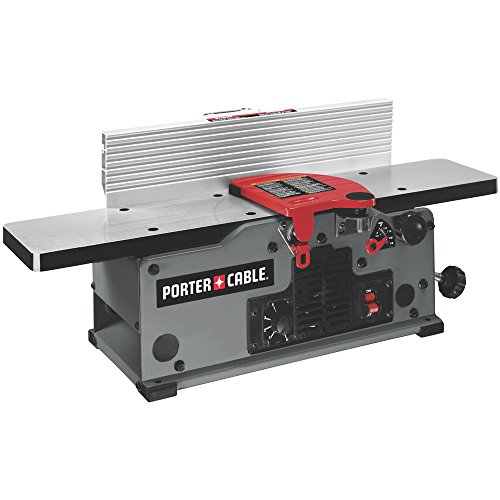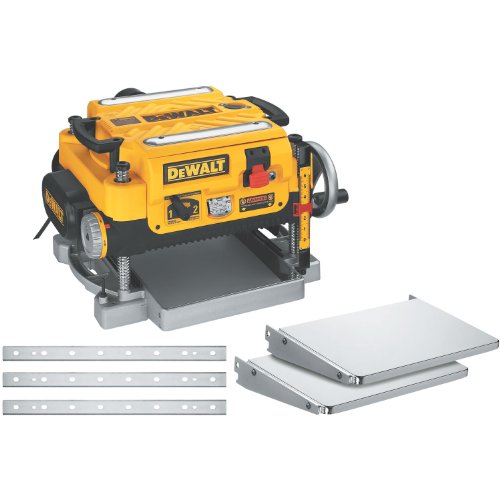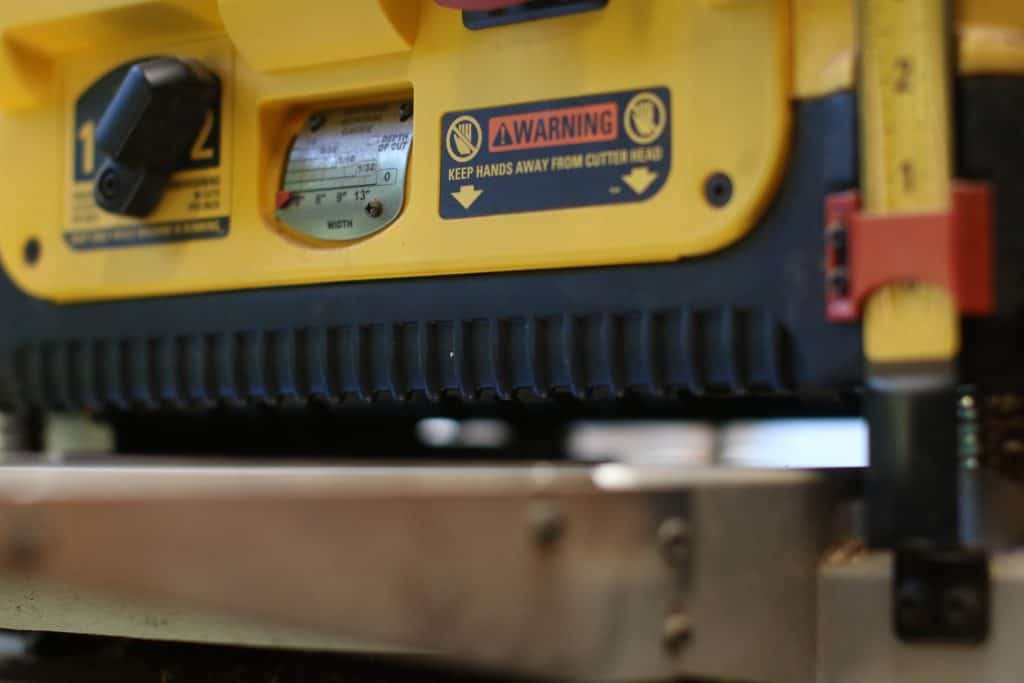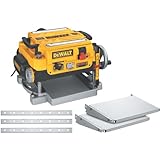Traditional woodwork is an art form that every craftsman should aspire to master at some point. Sadly, it’s not as efficient or time-saving as power milling with the aid of a jointer and planer.
Even though a lot of woodworkers are familiar with both planers and jointers, they’re not quite sure where the distinction between both tools lies.
Jointers and planers are two completely different tools that shouldn’t be mixed up. In this article, we’ll be pointing out the differences between the two and what they’re used for.
Top Jointers on the Market
We’ve written an entire review on the top jointer on the market, but here are a few favorites if you’re wrestling between jointers or planers.
Powermatic 1610086K Model 60HH

The 1610086K from Powermatic is considered the best of the best when it comes to jointers. This machine is built to handle large volumes of work with ease. It features a heavy-duty body that will last you for years to come. We’d highly recommend this machine for heavy-duty jointing.
The Powermatic unit features a helical cutter head that houses four-sided knives for a smoother and quieter jointing experience. In addition, it boasts lengthy, 73-inch tables that allow you to cut extra-long pieces of lumber. This is remarkable compared to regular jointers with 30-inch tables.
Moreover, the unit boasts a 38-inch fence that helps provide ideal support for longer stocks. The unit also features a dust-collection mechanism that helps keep your space clean and completely free of dust and debris. This 1610086K houses a 2HP motor that’s incredibly powerful yet quiet.
There are a few gripes, though. The unit is extremely heavy at 518 pounds, so you’re not going to move it very easily without help. Additionally, this isn’t really a user-friendly machine, so if you consider yourself a newbie, this isn’t the machine for you. Not to mention that it’s quite costly.
Pros
- Powerful 2HP motor
- Extra-large tables
- Four-sided knives
Cons
- Heavy and bulky
- Steep price tag
- Superior Finish: The helical cutterhead, with 54 four sided carbide inserts, provides smoother and...
- Fine-Tuned Cut Depth: Adjustment lever offers quick infeed table positioning
- Extended Workpiece Support: Extra long tables are mounted on dovetailed ways
Porter-Cable PC160JT 6″ Jointer

Maybe you’re not looking for something as serious as the above-mentioned Powermatic unit for your DIY projects and you’re looking for a machine that’s more affordable, this Porter-Cable unit offers its flattening abilities and immense power for a price tag that’s under $500.
Compared to the Powermatic 1610086K, this is a pretty small machine that you can move from one place to another with ease. Its compact size allows you to fit it in your workspace or garage without crowding up the area. Heck, you can even take it to work with you on top of a truck.
This brilliant machine has an incredible speed range of 6,000 to 11,000 RPM, which gives you a lot of speed-adjustment options to work with based on the density of the wood. You can flatten a piece of lumber that’s two times longer than the jointer itself, which is incredible for a small unit.
Just like any piece of machinery, there are downsides to this machine as well. The tabletop isn’t very durable considering it’s made from aluminum. Additionally, the fence tends to sway a lot, so you’re going to need to re-square it after each time you adjust it.
Pros
- Variable speed
- Solid warranty
Cons
- Flimsy aluminum back
- Oxidizable tables
- Variable 6,000 to 11,000 RPM speed range allows the user to select the right speed for the size and...
- Two knife cutter head with jack screw knife leveling arrangement for easy replacement and adjustment...
- Built-in cutter head lock facilitates knife replacement and adjustment
Best Planers on the Market Today
Dewalt DW735X Woodworking Planer

The Dewalt DW735X is the ideal unit for professional woodworkers. The machine is speed-adjustable, so you can either set to get a finishing or dimensioning cut. The stress of the planning is divided on the three knives housed inside the cutter head, allowing for a fine, parallel finish.
This planer boasts a pretty wide base that allows you to work with longer stocks without issues. It houses a powerhouse, 15-amp/20,000 RPM motor which is more capable of handling some of the hardest and toughest pieces of wood. It’s also pretty quiet considering how powerful it is.
The great thing about the DW735X is that it doesn’t require any mounting whatsoever. However, this planer weighs about 100 pounds, so it’s not really something that you’d like to move around often. Oh, and the knives within the cutter aren’t just disposable, they’re also reversible as well.
It says a lot about a machine if the only negative thing you have to say about it is that’s it’s hefty. Yes, it may not be the most portable unit on the market, but you’ll be hard-pressed to find a unit that weighs less and can perform at half the capacity of what this unit has to offer.
Pros
- Powerful motor
- Three-knife cutter
- Two-speed gearbox
Cons
- Bulky and heavy
- Expensive
- Purchase includes one stationary 13" Planer, in/out feed tables with fasteners (attached to the base...
- Three knife cutter head of the thickness planer delivers 30% longer knife life and makes knife...
- Two-speed gear box of the wood planer allows users to change feed speed to optimizing cuts per inch...
Dewalt DW734 Woodworking Planer

If only the DW735X was a little lighter, right? Well, the Dewalt DW734 shares a lot of the same attributes as the DW735X and it weighs about 20 pounds less. However, this speed on this unit isn’t adjustable. If you don’t care about a second-speed option, then this is the unit for you.
The DW734 offers 96 cuts for every inch, allowing for a smooth and even finish in no time. It has three knives within the cutter head that help reduce the stress off each other. Further, this model features a wide, extendable base that allows you to tackle longer pieces of wood with ease.
The majority of wood planers on the market tend to be quite noisy. Well, this isn’t one of them. It still produces audible noises and you’ll need to take heparin precautions, but it’s not as obvious as other units. The unit also features disposable and reversible knife blades for convenience.
To sum it up, this is a highly portable unit that provides a lot of value at a very reasonable price. It came to our attention from numerous user reviews that this unit eats blades, so this may not be the best unit to buy if planning is what you do to make a living.
Pros
- Three-knife cutter
- Extendable base
- Relatively lightweight
Cons
- Blade-hungry unit
- Powerful 15 amp, 20,000 rpm motor of the woodworking planer handles larger, deeper cuts in...
- Three-knife cutter head with 10,000 rpm cutter-head speed of the thickness planer provides 96 cuts...
- Disposable, reversible knives of the wood planer deliver 30% more knife life and make knife change...
Best Jointer-Planer Combos on the Market Today

Jet JJP-12 Jointer-Planer Combo
Looking for the best industrial-grade jointer-planer combo for heavy-duty workloads? It doesn’t get better than the Jet JJP-12. The unit has a compact, parallelogram shape that helps maintain great stability and keep the table near the cutter head. It’s a great choice for smaller shops.
The JJP-12 features an extra-large aluminum fence which provides adequate support to handle 12-inch stocks. The switchover between jointing and planing mode takes very little time, which helps you reap the luxury of time rather than spend it setting up the machine.
The JJP-12 houses a powerful 3HP motor that’s capable of handling any type of wood no matter how solid or rough-edged it is. Additionally, it allows for quick operation so that you can move on from one stock to the next within a matter of minutes.
There are two major gripes with this machine, though. The first one is that the blade is very poor and it actually hinders the machine’s performance. Luckily, the blade is replaceable. The second gripe is that the unit comes at a steep price tag, which is acceptable considering its power.
Pros
- Powerful 3HP motor
- Extra-large fence
- Quick changeover
Cons
- Heavy construction
- Costly investment
- RAPID CUTS: Three, high-speed, steel knife cutter head provides rapid cutting and a superior finish.
- ADAPTABLE: Extrmemly quick changeover between jointing and planing functions. Fence does not need to...
- STABILITY: Heavy-duty, one-piece steel closed stand (includes mounting tabs).
Rikon 25-010 Jointer-Planer Combo

Looking for a smaller, more affordable jointer-planer combo? The Rikon 25-010 is an incredible 10-inch machine. The switch between planer mode and jointer mode is pretty easy and takes place in under one minute.
The unit features 2 high-speed steel knives that are highly durable, a telescopic blade guard, an easy height-adjustment option, and large ergonomic knobs. In terms of performance, this combo will deliver remarkable smooth finishes in a short period of time.
The unit has a compact, 160-pound construction that’s a lot easier to move around than the Jet JJP-12. It houses a 1.5HP induction motor that provides it with enough power to handle 10-inch stocks and provide a maximum cutting depth of ⅛ inches. Highly recommended for DIY folks.
Pros:
- Lightweight and stable
- Quick height adjustment
- Features a dust port
Cons:
- The fence is hard to set
- The 25-010 has ribbed cast aluminum jointer tables, sturdy aluminum planer bed and 4-Inch dust port
- This quality space saving unit boasts a 1.5 hp induction motor to provide plenty of power for the...
- The power is transferred to the cutterhead by a flat ribbed drive belt (J-belt) to minimize...
Jointers
A typical jointer will be comprised of an infeed and outfeed table aligned together horizontally. It also features a cutter head mounted between the two tables in which cutting knives are housed.
Ideally, the infeed table should be positioned at a height that equates to the depth of wood you’ll be milling, while the outfeed one should be aligned with the tops of the knives in the cutter head.
You’ll also notice that jointers tend to have fences that are there for guidance. It will also provide support for the lumber to ensure its safety. The fence can be adjusted to different angles easily.
Operation
Operating a jointer is pretty simple. All you need to do is put the guard in place and then pass a piece of lumber across the infeed table to flatten it, while the outfeed table supports the result.
These tools come in all shapes and sizes, ranging from smaller benchtop options to larger cabinet models.
To put it simply, jointers are primarily designed to flatten, straighten, and square lumber boards. There are, however, things that a jointer can’t help you with, which is why you need a planer.
As we’ve mentioned, jointers allow you to set the thickness of your cut, but they’re not versatile enough to offer you the option to set the thickness of the finished lumber board.
Why does that matter? Well, if you’re going to use a jointer to cut more than one board that you want to be exactly the same thickness, it won’t be possible unless they have the same thickness initially.
Additionally, unless the jointer is set up perfectly and the board is firmly supported, you may not end up with parallel edges or faces. That becomes more apparent when jointing face sides.

Planers
Okay, so we’ve established that jointers are the ideal tools for flattening a lumber board, but fall short when it comes to producing parallel faces. That’s exactly what a planer is here to pull off.
Now that you have a few pieces of lumber with flat and square faces and edges, it’s time to give them a pass across a planer in order to get the exact thickness and parallelity you desire.
Similar to jointers, planers also have infeed and outfeed components, but in their case, it’s rollers rather than tables. In between the infeed and outfeed roller, you can find a cutter head as well.

Operation
It seems like the planer isn’t any different from a jointer, so how exactly do you get the thickness you want? Well, the distance between the cutter head and the roller determines the thickness.
Basically, the stock of lumber passes across the infeed roller where it comes in contact with the cutter head. The outfeed roller then grabs the stock and then take it out of the planer.
There’s a bit of a gripe when it comes to planers, though. Depending on your planer, the amount of wood that it can remove per pass can be very limited, which sometimes requires you to make more than one pass.
Another con that planers suffer from is that they tend to duplicate the defects on one side of the stock onto the other side, which is why it’s imperative to run your lumber across a jointer first.
On a positive note, planers allow you to flatten a rough board of wood that’s reasonably straight without the need for it to be pre-milled. Just a few passes and it will be both flat and parallel.
There are also great handheld electric planer options, which can be used in smaller instances where you need to taper a piece of wood. One prime example is when you have a new door that is just slightly too long; you can plane it down to fit.
Jointer-Planer Combo
No, jointer-planer combos aren’t merely wider jointers. There are actually units that combine the two machines together to bring you the best of both worlds so that you never need help from the lumberyard with preparations.
Jointer-planer combos offer you both the operation and features that jointers and planers deliver separately. And the best thing about such units is that they use a single cutting head for both.
How is having one cutting head beneficial to you? For starters, you get a wider jointer. Also, you now have the ability to make cuts with ideal parallelity and exact thicknesses.
But what exactly the secret behind this convenient union? The secret is that jointer-planer units have two beds instead of one, which isn’t noticeable at all since it just looks like a wide jointer.

Below the jointer bed, you can find the second bed mounted below the cutter bit, which happens to be an adjustable bed. Simply adjust its height to your liking to achieve the right thickness.
You don’t really need to do much in order to switch from jointing mode to planning mode. Simply swing the dust collector between its two positions to switch modes. It acts as a blade guard too.
You can find 8-inch and 12-inch jointer-planer combinations on the market. The former tends to have a pretty small planer, which is why we advise going for a 12-inch model instead.
The best thing about jointer-planer combos isn’t just that allow two operations under one roof, but they can also help save a lot of space that would have otherwise been filled by the planer.
[lyte id=’VwLJc8uxqaI’ /]
Conclusion
Much of the confusion around the entire jointer vs planer matter stems from the similarity in the operation of both machines, and that’s about it. However, both tools are used for two completely different purposes.
It’s not possible for jointers to do planers’ work, and vice versa. Jointers are used to achieve flat faces, while planers are used to produce parallel faces.
While it’s not necessary to have both a jointer and planer in your workshop if you’re a master at hand-milling, we find it hard to believe that one can get a square, coplanar piece of lumber with parallel edges and faces manually in a short period of time.
If time is valuable and woodworking is something that you do for a living, we’d highly recommend getting both units either separately or as a jointer-planer combo.






